‘Indian Blood’ and American Identity
Gregory Hood, American Renaissance, October 28, 2022
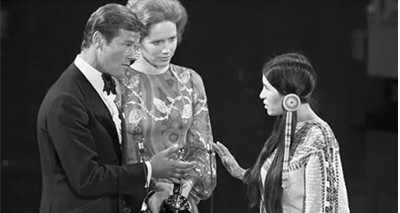
Credit Image: © Sheedy & Long Photography/AMPAS via ZUMA Press Wire
The late Sacheen Littlefeather died a hero. She was the “American Indian” Marlon Brando chose to refuse his Academy Award in 1973. Littlefeather said Brando was protesting “the treatment of American Indians today by the film industry” and “recent happenings at Wounded Knee.” The latter referred to a deadly standoff between American Indian activists and federal authorities.
Miss Littlefeather’s speech was short, and some in the audience booed. Whites weren’t entirely cowed back then, and “woke” politics weren’t a career requirement for celebrities. Littlefeather claimed John Wayne had to be physically restrained from pushing her off-stage. Clint Eastwood joked that maybe he should present an award “on behalf of all the cowboys shot in all the John Ford Westerns over the years.”
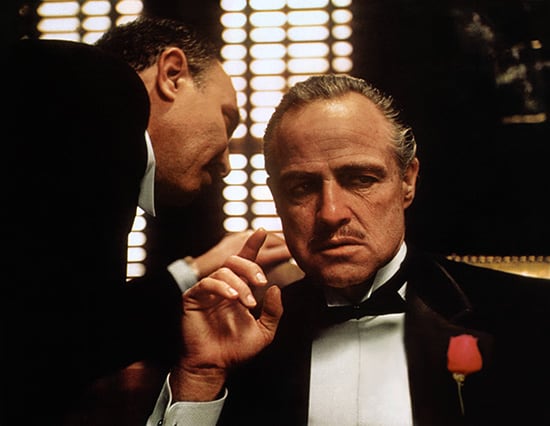
Marlon Brando as Vito Corleone in The Godfather. (Credit Image: © Imago via ZUMA Press)
Now is a different time. George Floyd’s death in 2020 and the associated movement led progressives to finally conquer the state and impose a new, anti-white official American culture. Once-fringe concepts such as “land acknowledgements,” “Indigenous Peoples’ Day,” or honoring slaves rather than the Founding Fathers are mainstream.
In 2020, Californians proposed removing tributes to John Wayne, such as taking his name off the Orange County airport. Even a decade ago, Quentin Tarantino said he “hates” John Ford and his Westerns because they elevated “Anglo-Saxons.” Since the conquest of the West arguably defines America, attacks on Christopher Columbus, Western settlers, and cowboys mean that it would have been better if whites never came. We don’t belong here. American Indians are the “true” Americans.
Ideas like this have consequences. The Afrikaners have been in South Africa for about as long as whites have been in America. If their presence in Africa is illegitimate, so is ours here. Afrikaners’ cultural dispossession preceded political and physical destruction. South Africa today is the result.
That’s why Littlefeather’s legacy matters. She was an early glimpse of a now triumphant cultural movement. In 2021, The Guardian saluted her for being the “first woman of colour, and the first indigenous woman, to use the Academy Awards platform to make a political statement.” It compared her to “John Wayne, serial slaughterer of Native Americans on-screen and self-professed white supremacist.” In 2016, Jada Pickett Smith said Littlefeather was the inspiration for her boycott of the Oscars because of its alleged lack of diversity, something the LA Times said then-host Chris Rock should emphasize. This is amusing because Mrs. Smith’s husband Will slapped host Chris Rock at the most recent Academy Awards, stealing all the headlines. The political speechifying at the Oscars may be why many Americans don’t watch anymore.
In August 2022, the Academy of Motion Picture Arts and Sciences apologized to Littlefeather for the “unwarranted and unjustified” treatment she received back in 1973. “For too long the courage you showed has been unacknowledged,” said former Academy president David Rubin. “For this, we offer both our deepest apologies and our sincere admiration.” Littlefeather said, “We Indians are very patient people.”
On September 17, the Academy groveled further by hosting “An Evening with Sacheen Littlefeather.” It included a land acknowledgement, a long interview with Littlefeather, and various entertainment acts, including Indians dancing in supposedly traditional garb. Earlier this month, Littlefeather died, to much praise.
- Sacheen Littlefeather: Native American activist and actor who refused Oscar for Brando dies, BBC, October 3, 2022
- Indigenous Rights Activist Sacheen Littlefeather Dies at 75, by Brigit Katz, Smithsonian Magazine, October 3, 2022
- Sacheen Littlefeather, who declined Brando’s Oscar, dies at 75: The first Native American woman to stand onstage at the Oscars, she made headlines for calling attention to discrimination and injustice against American Indians, by Harrison Smith, Washington Post, October 3, 2022
She may not have been an American Indian at all. “Littlefeather’s” sisters now say she lied. “It was more prestigious to be an American Indian than it was to be Hispanic in her mind,” said one. Jacqueline Keeler at the San Francisco Chronicle broke the story as part of her effort to compile what she calls “Pretendians.” She found no links between “Littlefeather” and any of the tribes she claimed, including the Apache and Yaqui. “Based on an examination of her family tree, at most, it could be said she self-identifies as such, but on what basis, we do not know,” she wrote charitably.
This wasn’t the first time Littlefeather’s credentials were challenged. Roger Ebert — no conservative — wrote in a 2004 column memorializing Marlon Brando that Littlefeather was really “Maria Cruz, an actress who was not an Indian.” Lawyers wrote a stiff letter to Ebert claiming that Littlefeather was the child of “an Anglo-Saxon mother and a father who was Yaqui and White Mountain Apache.” Littlefeather’s own “authorized website” repeats the claims about her father but says her mother was “French-German-Dutch.”
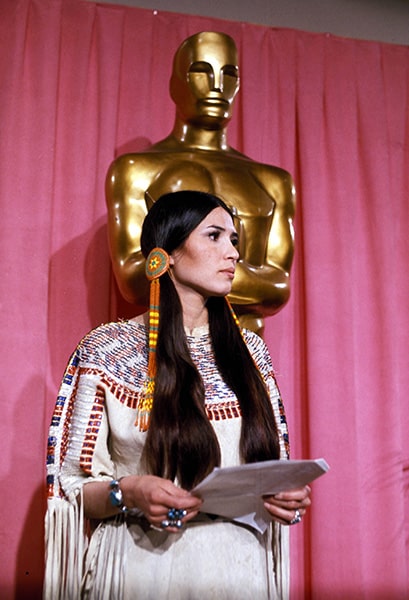
Sacheen Littlefeather (Credit Image: © Globe Photos/ZUMA Press Wire)
However, mainstream publications are running the “lie” story.
- Sacheen Littlefather’s [sic] sisters say she was not Native American. The actress had disputed similar claims before. By Caitlin O’Kane, CBS News, October 24, 2022
- Sacheen Littlefeather Lied About Native American Ancestry, Sisters Claim, by Daniel Kreps, Rolling Stone, October 22, 2022
- Sacheen Littlefeather’s sisters claim she wasn’t Native American: It’s ‘a lie,’ by Samantha Ibrahim, New York Post, October 24, 2022
Littlefeather was lucky her sisters waited until she was dead. Perhaps her estate will produce proof she was an Indian. If not, she’s certainly not the first woman who claimed to be a different race because it comes with privileges. We may never have heard of Elizabeth Warren if she hadn’t claimed to be an Indian, but her lack of tribal blood may have sunk her presidential campaign. Rachel Dolezal made quite a career being black before she was exposed, but she kept “identifying” as black anyway.
The Hispanic Littlefeather’s claim is interesting in light of Rep. Alexandria Ocasio-Cortez’s theory about Hispanics: They are all American Indians, and should be exempt from immigration laws. Perhaps if Littlefeather had lived a little longer, she would have shifted to this position.
Even for race realists, it may seem crass to talk about “Indian blood,” but that’s the term the federal government uses. It requires a “Certificate of Degree of Indian or Alaska Native Blood” (CDIB) if you want to claim membership in a “recognized tribe.”
The Cherokee Nation, for example, says an Indian must have at least one direct ancestor listed on the 1898–1906 Dawes Census. “Your blood quantum will be computed and placed on your CDIB,” its website says.
In 2011, NPR reported that American Indians intermarry more than any other group in the country. The 2010 Census showed about half of American Indians and Alaska Natives were multiracial. This is a problem because to enroll in most tribes, you have to be at least one-quarter Indian.
Many people want in. From 2010 to 2020, the Census found that the number of American Indians grew by more than four million. Immigration and birthrates can’t explain that; people want to be Indians.
This is new. The Declaration of Independence refers to “merciless Indian savages,” taking for granted that they are not Americans. Indians didn’t get blanket US citizenship until 1924. However, the racial barriers between whites and Indians were never as strong as between blacks and whites.
The Pocahontas-Captain John Smith romance may be exaggerated, but in 1614, the Indian princess did marry tobacco planter John Rolfe. She converted to Christianity and toured England, even visiting Whitehall. In the 1700s, Virginian historian Robert Beverly bemoaned the lack of intermarriage between Indians and Europeans, which he blamed for the violence between the two groups. The South’s premier university, The College of William & Mary, had an Indian school from 1700 onward, and colonial officials worked hard to get tribes to send students. One cannot imagine the aristocracy of Old Virginia promoting miscegenation and education as ways to bridge the black-white divide.
Indian violence, especially the near genocide of New England colonials in King Philip’s War, were a great boost to white racial consciousness in America. There was also some “red” consciousness. Tecumseh tried to build a pan-Indian alliance to fight whites.
Whites fought other whites for domination in North America, with various Indian groups taking different sides. Most of the Iroquois Confederacy helped the British during the Revolution, but the Oneida helped George Washington, leading the tribe to claim, with truth, that it was America’s “First Ally.” Stand Watie, a Cherokee, was the last Confederate general to surrender in the War Between the States. The Comanche practically exterminated other tribes, and non-Comanches seeking revenge helped the cavalry put them down.
American Indians represented a cultural challenge that blacks never did. Whites had a wary respect for them and there was some discussion of assimilation. Nineteenth century Americans praised great Indian warriors even in their own time. For example, Americans honored the Creek chief Alexander McGillivray (half-white) and the great Seminole leader Osceola (quarter-white). Today, America’s military arsenal boasts “Apache,” “Chinook,” and “Black Hawk” helicopters and the famous “Tomahawk” missile. While we can’t rule out what our rulers have in store in the future, Americans have so far named no tank or military base for Nat Turner.
The Comanche’s last chief was Quanah Parker. He was half-white, the son of Cynthia Ann Parker, a white woman whom the Comanche kidnapped when she was nine and who married a chief. Her story was the basis for John Ford’s The Searchers, probably the most famous Western of all time. It starred John Wayne. Many who complain about the way Hollywood treated American Indians start with this film.
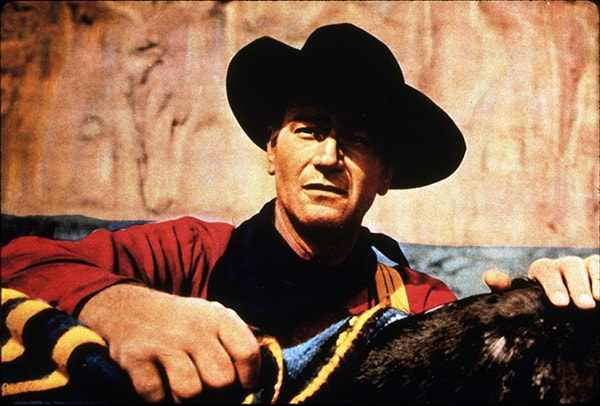
John Wayne as Ethan Edwards in The Searchers. (Credit Image: SNAP/ZUMAPRESS.com) (Credit Image: © SNAP/Entertainment Pictures/ZUMAPRESS.com)
But the story is more complex. Despite seeing Comanches torture and butcher her family, Cynthia Ann Parker joined her kidnappers. She was miserable after being “rescued” by whites. That is what lies behind Ethan’s (John Wayne’s character) sneer that Comanche captives “ain’t white anymore,” why he considers killing the kidnapped white woman “Debbie,” and why Debbie’s joy at being saved is fiction.
The simplistic story of whites crushing Indians insults them and us. They were warriors, not victims. They weren’t “Native Americans” because they were not Americans until they were conquered or assimilated. They had their own identities.
For every story of white settlers fighting Indians, there is a story of Indians allying with whites to fight other Indians. In the last century, they were the American equivalent to the British Gurkhas, serving in the Rough Riders during the Spanish-American War (when the Army was racially segregated) and as messengers in World War II. When Major League Baseball was still racially segregated, American Indian Jim Thorpe played for the New York Giants (now the San Francisco Giants).
No other group enjoys self-rule and citizenship the way they do. No other officially privileged identity is protected by such strict guidelines. It’s not surprising that many Americans, even Hispanics like “Littlefeather,” envy their special status and identity.
“Sacheen Littlefeather was a deeply troubled soul who struggled mightily with issues of identity and acceptance,” wrote Michael Cieply in Deadline earlier this week. Her father, the supposed Indian, was a violent alcoholic, yet that was the race she claimed. She suffered from mental problems and many of her claims are questionable. She deserves either contempt or pity for inventing an “oppressed” identity and trading on it her entire life.
These things don’t happen in a vacuum. Littlefeather never got to give Marlon Brando’s full speech. He argued that Hollywood is “as responsible as any for degrading the Indian and making a mockery of his character, describing his as savage, hostile, and evil.” He said Indian children have their minds “injured in ways we can never know.” Those who wish they are the ones being oppressed are far more mentally injured. We should be asking ourselves what built that climate.
Brando’s claim that the industry smeared Indians is also questionable. Just four years after The Searchers and 13 years before Brando’s protest, Elvis Presley played a “half-breed” in a film where the villains are whites who don’t treat Indians equally. The worst that can be said here is that Elvis wasn’t an Indian, but then, neither was Littlefeather.
Defining non-white identity as white oppression is condescending and cynical, and it disgraces everyone. It’s especially contemptible when the American Indian is used as a caricature of innocence. Why shouldn’t a mostly white country make movies for a mostly white audience about the historical fact that Indians attacked white settlers, often brutally? American Indians have a real history. Reducing them to a symbol of peace encourages more phony Indians.
The most notorious example may be “Iron Eyes Cody,” a character actor who played the “noble Indian” in many films. His most famous role was as the “crying Indian” in an environmentalist ad suggesting whites destroyed America. His real name was Espera Oscar de Corti and he was Italian. The Sopranos cited this in an episode satirizing the way ethnic groups in America compete for victim status.
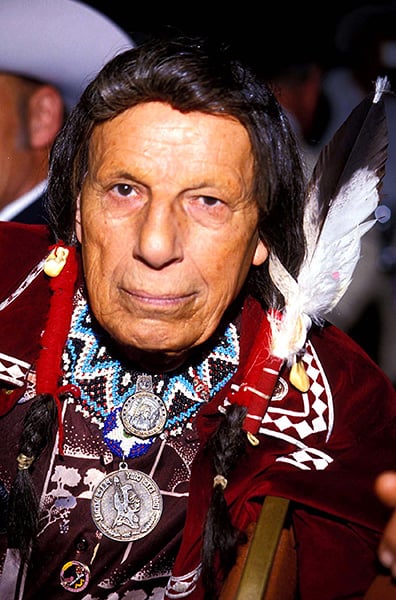
“Iron Eyes Cody” in 1987. (Credit Image: © Bob V Noble/ZUMA Wire)
The Academy and the media’s recent celebration of Littlefeather shows the deep moral sickness of our culture. She was misguided or a liar, but we can expect only embarrassed silence from the Academy.
Brando’s supposedly noble stance for Indians became a liability in 1996. He said who he thought was responsible for pushing movie stereotypes: Jews. This was left out of the recent media celebrations of Littlefeather’s supposed heroism. Brando eventually made a weeping apology to a group of rabbis, prompting Norm MacDonald to joke about it.
Mockery’s the best response. In America, claims of victimhood are demands for power. Scorn them. A culture in which people invent a fake identity to pursue wealth or soothe emotional needs is morally bankrupt.
Identity is mostly built in. It can’t be changed by wishing it away. Maybe we should encourage the federal government to expand its Indian policy to other racial groups. A government-mandated “Certificate of Blood” (CB) would spare us the spectacle of phonies faking victimhood. But what we really need is some kind of self-government, even the supposedly degraded form Indian tribes get. It would be a lot better than having no explicit representation in the country our ancestors built.















